
5990 Results

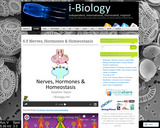
6.5 Nerves, Hormones & Homeostasis | i-Biologyi-biology.net/ibdpbio/06-human-health.../nerves-hormones-homeostasis/Cached
SimilarEssential Biology 6.5 Nerves, Hormones and Homeostasis .........o0O0o. ... Tutorial and game from think-bank ..... Online Learning ... Creative Commons License
- Subject:
- Anatomy/Physiology
- Biology
- Life Science
- Material Type:
- Diagram/Illustration
- Interactive
- Unit of Study
- Provider:
- i-Biology
- Author:
- Stephen Taylor
- Date Added:
- 02/03/2014

In this course, you will learn the principles of genetics with application to the study of biological function at the level of molecules, cells, and multicellular organisms, including humans. We will cover structure and function of genes, chromosomes, and genomes; biological variation resulting from recombination, mutation, and selection; population genetics; and the use of genetic methods to modify genes and genomes and analyze protein function, gene regulation, and inherited disease.
This course, based on the MIT course 7.03 Genetics taken by enrolled MIT students, was organized as a three-part series on edX by MIT’s Department of Biology (Note: The third part of the course is not available yet). It is self-paced and free as long as you enroll in the Audit Track option, which you can select after creating a free account on edX.
- Subject:
- Biology
- Life Science
- Material Type:
- Full Course
- Provider Set:
- MIT OpenCourseWare
- Author:
- Friend, Caitlin
- Gordon, Darcy
- Hemann, Michael
- Reddien, Peter
- Wiltrout, Mary Ellen
- Yang, Mingyu
- Date Added:
- 02/01/2023

In this course, you will engage in the biology of cells of higher organisms. You will study the structure, function, and biosynthesis of cellular membranes and organelles; cell growth and oncogenic transformation; transport, receptors, and cell signaling; the cytoskeleton, the extracellular matrix, and cell movements; cell division and cell cycle; functions of specialized cell types. This course emphasizes the current molecular knowledge of cell biological processes as well as the genetic, biochemical, and other experimental approaches that resulted in these discoveries.
This course, based on the MIT course 7.06 Cell Biology taken by enrolled MIT students, was organized as a three-part series on edX by MIT’s Department of Biology. It is self-paced and free as long as you enroll in the Audit Track option, which you can select after creating a free account on edX.
- Subject:
- Biology
- Life Science
- Material Type:
- Full Course
- Provider Set:
- MIT OpenCourseWare
- Author:
- Avello, Monika (Moni)
- Cheeseman, Iain
- Friend, Caitlin
- Gordon, Darcy
- Lamason, Rebecca
- Lourido, Sebastian
- Wiltrout, Mary Ellen
- Yang, Mingyu
- Date Added:
- 02/01/2023
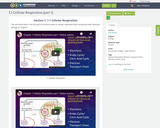

This course is an in-depth adventure through the molecular mechanisms that control the maintenance, expression, and evolution of prokaryotic and eukaryotic genomes. Through lectures and readings of relevant literature, students will explore gene regulation, DNA replication, genetic recombination, transcription, and mRNA translation. The quizzes are designed to build students’ experimental design and data analysis skills.
This course, based on the MIT course 7.28/7.58 Molecular Biology taken by enrolled MIT students, was organized as a three-part series on edX by MIT’s Department of Biology. It is self-paced and free as long as you enroll in the Audit Track option, which you can select after creating a free account on edX.
- Subject:
- Biology
- Life Science
- Material Type:
- Full Course
- Provider Set:
- MIT OpenCourseWare
- Author:
- Baker, Tania
- Bell, Stephen
- Carr, Swati
- Schafheimer, Nathaniel
- Thornton, Sera
- Wiltrout, Mary Ellen
- Date Added:
- 02/01/2023


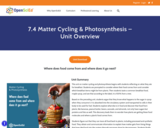
This unit on matter cycling and photosynthesis begins with students reflecting on what they ate for breakfast. Students are prompted to consider where their food comes from and consider which breakfast items might be from plants. Then students taste a common breakfast food, maple syrup, and see that according to the label, it is 100% from a tree.
Based on the preceding unit, students argue that they know what happens to the sugar in syrup when they consume it. It is absorbed into the circulatory system and transported to cells in their body to be used for fuel. Students explore what else is in food and discover that food from plants, like bananas, peanut butter, beans, avocado, and almonds, not only have sugars but proteins and fats as well. This discovery leads them to wonder how plants are getting these food molecules and where a plant’s food comes from.
- Subject:
- Biology
- Life Science
- Material Type:
- Unit of Study
- Provider:
- OpenSciEd
- Date Added:
- 02/26/2020
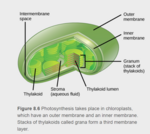

9 major animal phyla
- Subject:
- Biology
- Life Science
- Material Type:
- Diagram/Illustration
- Date Added:
- 11/07/2018

This illustration highlights the characteristics of the 9 major phyla of animals
- Subject:
- Biology
- Life Science
- Material Type:
- Diagram/Illustration
- Date Added:
- 11/07/2018

This resource is a video abstract of a research paper created by Research Square on behalf of its authors. It provides a synopsis that's easy to understand, and can be used to introduce the topics it covers to students, researchers, and the general public. The video's transcript is also provided in full, with a portion provided below for preview:
"Traumatic brain injury (TBI), or brain damage caused by a sudden blow or jolt to the head, is a leading cause of death and disability worldwide. The mechanisms are complex and differ among patients, making TBI difficult to treat, and anti-inflammatory agents that are effective in animal models have been less promising in human trials, indicating that better treatments are needed. To explore new strategies, a recent study investigated the effect of the anti-inflammatory compound ACT001 on TBI. In mice, ACT001 reduced brain damage and improved motor function after TBI by reducing trauma-induced activation of microglia, which are immune cells of the central nervous system. In vitro, ACT001 also reduced activation of mouse and rat microglia induced by the bacterial toxin lipopolysaccharide (LPS) and downregulated LPS-induced secretion of proinflammatory molecules in a mouse microglial cell line..."
The rest of the transcript, along with a link to the research itself, is available on the resource itself.
- Subject:
- Biology
- Life Science
- Material Type:
- Diagram/Illustration
- Reading
- Provider:
- Research Square
- Provider Set:
- Video Bytes
- Date Added:
- 05/18/2022

This resource is a video abstract of a research paper created by Research Square on behalf of its authors. It provides a synopsis that's easy to understand, and can be used to introduce the topics it covers to students, researchers, and the general public. The video's transcript is also provided in full, with a portion provided below for preview:
"Myocardial infarction (MI), or heart attack, can cause long-term damage that leads to heart failure. To treat this type of heart failure, it’s critical to heal the pathological structural changes in the heart and preserve cardiac function. A recent study investigated potential treatment targets by exploring the role of the enzyme ADAM17, whose levels are increased during MI. In a group of 152 patients with MI, high ADAM17 levels were associated with a greater incidence of subsequent heart failure, as well as poorer heart function and higher mortality, suggesting a negative role of ADAM17. In mice with MI, elevated ADAM17 levels were linked to heart damage, but blocking ADAM17 activity limited the cardiac damage and remodeling after MI. Experiments in cultured heart cells revealed that ADAM17 exerted its harmful effects by promoting loss of the cardioprotective enzyme ACE2 and that the activation of ADAM17 depended on modification of a specific site in the protein p38 MAPK..."
The rest of the transcript, along with a link to the research itself, is available on the resource itself.
- Subject:
- Biology
- Life Science
- Material Type:
- Diagram/Illustration
- Reading
- Provider:
- Research Square
- Provider Set:
- Video Bytes
- Date Added:
- 04/17/2023

The coral reefs of the South Pacific island nation of Vanuatu are the backbone of the island's environmental and economic health. Today they face destruction from a silent predator that can rapidly decimate an entire reef. In this video, students learn about how a starfish is destroying the coral reefs of Vanuatu and how the islanders are adapting.
- Subject:
- Applied Science
- Biology
- Ecology
- Economics
- Environmental Science
- Life Science
- Physical Science
- Social Science
- Material Type:
- Diagram/Illustration
- Reading
- Provider:
- CLEAN: Climate Literacy and Energy Awareness Network
- Provider Set:
- CLEAN: Climate Literacy and Energy Awareness Network
- Author:
- LearningMedia
- Public Broadcasting Service
- Date Added:
- 08/01/2022
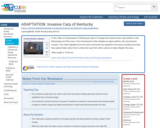
In this video, an entrepreneur is finding new ways to manage the invasive Asian carp problem in the Mississippi and Ohio rivers. Once introduced to help mitigate an algae problem, the carp became invasive. This video highlights how the local community has adapted to the issue, including how they have gained ideas about how to utilize the carp from other cultures to help mitigate the issue.
- Subject:
- Applied Science
- Biology
- Ecology
- Economics
- Environmental Science
- Life Science
- Physical Science
- Social Science
- Material Type:
- Diagram/Illustration
- Reading
- Provider:
- CLEAN: Climate Literacy and Energy Awareness Network
- Provider Set:
- CLEAN: Climate Literacy and Energy Awareness Network
- Author:
- LearningMedia
- Public Broadcasting Service
- Date Added:
- 08/01/2022

This exercise should be used after you think students know what AFM diagrams are and how they work. This is sort of a quiz -- to see if they can properly interpret the diagrams. There is no point moving on to real projects that involve AFM diagrams if the students don't understand the basics.
(Note: this resource was added to OER Commons as part of a batch upload of over 2,200 records. If you notice an issue with the quality of the metadata, please let us know by using the 'report' button and we will flag it for consideration.)
- Subject:
- Biology
- Life Science
- Physical Science
- Physics
- Material Type:
- Activity/Lab
- Provider:
- Science Education Resource Center (SERC) at Carleton College
- Provider Set:
- Teach the Earth
- Author:
- Dexter Perkins
- Date Added:
- 08/17/2019

This resource is a video abstract of a research paper created by Research Square on behalf of its authors. It provides a synopsis that's easy to understand, and can be used to introduce the topics it covers to students, researchers, and the general public. The video's transcript is also provided in full, with a portion provided below for preview:
"Healthy corneas are clear and lack blood vessels, but injuries like alkali burns can trigger neovascularization. This serious complication reduces the patient’s vision and is the leading cause of failure in corneal transplants. Previous studies have suggested that AIP1 (Apoptosis signal-regulating kinase 1-interacting protein) is involved in inflammatory neovascularization induction and that NOX4 (NADPH oxidase 4) is activated by alkali burns. NOX4 can produce reactive oxygen species (ROS) which unbalance the expression of the inflammation-related proteins NLRP3 and NLRP6 (NLR family pyrin domain containing 3 and 6). Researchers recently used a mouse model to examine how AIP1 and NOX4 are related to NLRP3/NLRP6 after corneal alkali burns. Corneal alkali burns decreased AIP1 expression and increased the expression of two pro-angiogenic proteins, clv-IL-1β (cleaved interleukin-1β) and VEGFa (vascular endothelial growth factor A)..."
The rest of the transcript, along with a link to the research itself, is available on the resource itself.
- Subject:
- Biology
- Life Science
- Material Type:
- Diagram/Illustration
- Reading
- Provider:
- Research Square
- Provider Set:
- Video Bytes
- Date Added:
- 05/18/2022

This resource is a video abstract of a research paper created by Research Square on behalf of its authors. It provides a synopsis that's easy to understand, and can be used to introduce the topics it covers to students, researchers, and the general public. The video's transcript is also provided in full, with a portion provided below for preview:
"Some proteins are central to many cell signaling processes. One of these key molecules is AKT2. An important kinase involved in cell survival, growth, and metabolism, it has ties to insulin-induced signaling and cancer. AKT2 has a critical role in immune cells such as neutrophils and macrophages; however, although AKT2 is expressed in antibody-producing immune cells called B cells, its function in B cells isn’t clear. In a recent study, researchers sought to understand the role of AKT2 in B cells using AKT2-deficient mice. They found that mice lacking AKT2 had impaired B-cell differentiation. B cells from these mice were not able to form a cluster of molecules called a signalosome in response to B-cell receptor (BCR) signaling, resulting in poor BCR signaling and impaired B cell activation and spreading. These results suggest that as a central orchestrator of signaling, AKT2 function is critical for proper BCR signaling and B cell development, ensuring a functional antibody-mediated immune response..."
The rest of the transcript, along with a link to the research itself, is available on the resource itself.
- Subject:
- Biology
- Life Science
- Material Type:
- Diagram/Illustration
- Reading
- Provider:
- Research Square
- Provider Set:
- Video Bytes
- Date Added:
- 06/23/2020

This resource is a video abstract of a research paper created by Research Square on behalf of its authors. It provides a synopsis that's easy to understand, and can be used to introduce the topics it covers to students, researchers, and the general public. The video's transcript is also provided in full, with a portion provided below for preview:
"Gq protein-coupled receptors (GqPCRs) are membrane bound proteins that transmit signals from outside the cell to internal signaling pathways. One of these pathways is the PI3K/AKT pathway, which plays roles in cellular proliferation, survival, metabolism, and differentiation. PI3K/AKT dysregulation is also often implicated in cancers. A previous study determined that activating GqPCRs in certain cells inactivated AKT, which led to a specific type of cell death, JNK-dependent apoptosis. This unique signal seems to play an important role in physiological and pathological events like pituitary development and cardiac hypertrophy. Now, a new study determined that the mechanism of this AKT inactivation relies on another signaling-related protein, PP2A. When the GqPCRs are not activated, a fraction of PP2A "c" subunit is in a dimer complex with another protein, IGBP1 and they are bound to the p85 subunit of PI3K, causing its activation..."
The rest of the transcript, along with a link to the research itself, is available on the resource itself.
- Subject:
- Biology
- Life Science
- Material Type:
- Diagram/Illustration
- Reading
- Provider:
- Research Square
- Provider Set:
- Video Bytes
- Date Added:
- 01/11/2022